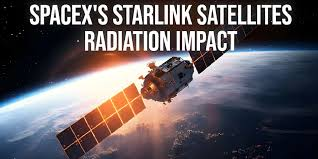Starlink Satellites Disrupt Astronomy, Prompt Regulatory Calls
Why in the news?
New research reveals that Starlink satellites create significant radio noise, impairing astronomical observations and sparking urgent discussions about the need for regulatory measures on satellite emissions.
About the Impact of Starlink Satellites on Astronomy:
- Interference with Observations: A study in Astronomy & Astrophysics reveals that Elon Musk’s Starlink satellites are disrupting astronomers’ work by creating unintended electromagnetic radiation (UEMR).
- Starlink’s Scale: Over 6,300 satellites currently orbit Earth at approximately 550 km, providing internet access to remote areas but generating significant radio noise that hampers radio astronomy.
Blinding Effects on Radio Astronomy:
- Nature of Radio Astronomy: Unlike optical telescopes that detect visible light, radio telescopes focus on radio waves, making them susceptible to interference from bright signals, akin to trying to see stars near a full Moon.
- Saturation Issue: Scientists describe the interference as “blinding,” where excessive light prevents proper observations, leading to saturation of data collection.
Call for Regulation:
- Growing Concerns: New Starlink satellites emit UEMR 32 times brighter than their predecessors, raising alarm as the satellite count could reach 100,000 by
- Need for Regulatory Measures: Experts advocate for regulations on satellite emissions similar to those in place for ground-based electronic sources, emphasising the importance of minimising radio pollution.
- Collaboration with Industry: Currently, astronomers are relying on cooperation with satellite companies to address these issues.
About the Starlink Project:
- Initiation: Launched by SpaceX in
- Objective: Build a low-cost, satellite-based broadband network for global internet access.
- Satellite Orbit: Positioned between 350 km and 1,200 km in Low Earth Orbit (LEO).
- Key Benefit: Reduced latency in data transmission due to proximity to Earth.
Impact of Solar Storms
- Definition: Solar storms involve solar flares and coronal mass ejections from the Sun.
- Effects on Earth: Can create phenomena like the Northern Lights in Arctic regions.
- Adverse Effects: Disruption of satellites and electronic communications.
Sources Referred:
PIB, The Hindu, Indian Express, Hindustan Times




